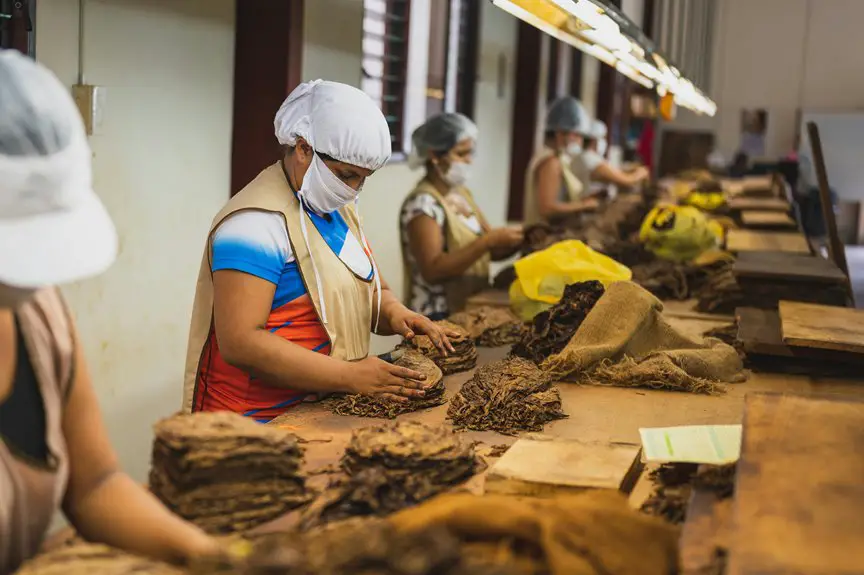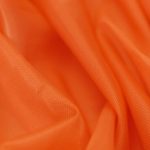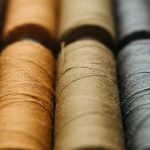Thermal bonding joins nonwoven fabrics by melting thermoplastic fibers like polyester or polypropylene using heat and pressure, creating a strong, durable material without adhesives. You’ll find this method quick, clean, and eco-friendly since it avoids chemicals and reduces waste. Temperature and pressure control are key to guarantee uniform bonding and fabric quality. Though it works best with synthetic fibers, it excels in many industries. Keep exploring to discover how this process shapes fabric performance and environmental benefits.
Table of Contents
Key Takeaways
- Thermal bonding joins fibers in nonwoven fabrics using heat and pressure, melting fibers to create strong, durable bonds without adhesives or chemicals.
- Synthetic thermoplastic fibers like polypropylene, polyethylene, and polyester are ideal for thermal bonding due to their melting and fusion properties.
- Key thermal bonding techniques include hot air bonding and calendaring, which apply controlled heat and pressure to fuse fibers uniformly.
- Precise control of temperature and pressure is essential to ensure strong bonds without damaging or distorting the fabric.
- Thermal bonding offers environmental benefits by eliminating adhesives, reducing waste, and lowering chemical and energy usage in fabric production.
What Is Thermal Bonding?
Thermal bonding is a process that joins fibers in nonwoven fabrics by applying heat and pressure. When you use thermal bonding, you’re fundamentally melting certain fibers just enough for them to stick together without turning the whole fabric into a solid mass.
This creates a strong, durable fabric that holds its shape well. You’ll find this method popular because it’s clean, fast, and doesn’t require adhesives or chemicals, making it environmentally friendlier.
By controlling temperature and pressure, you can tailor the fabric’s strength and flexibility to fit specific needs.
Types of Fibers Suitable for Thermal Bonding
You’ll find that synthetic fibers work best for thermal bonding because they melt and fuse under heat.
Natural fibers, on the other hand, don’t bond as easily since they lack this melting property.
Understanding these differences helps you choose the right materials for your nonwoven fabric projects.
Synthetic Fibers Compatibility
Although not all synthetic fibers respond equally, many are well-suited for bonding through heat because of their melting points and molecular structures.
When you work with polypropylene, polyethylene, or polyester, you’ll find they melt at temperatures ideal for thermal bonding, allowing fibers to fuse without degrading. These fibers’ thermoplastic nature means they soften under heat and solidify upon cooling, creating strong bonds.
Nylon and acrylic fibers can also be compatible but require more precise temperature control due to higher melting points.
When selecting fibers, consider their thermal behavior to guarantee effective bonding without damage. Understanding these properties helps you optimize the manufacturing process, resulting in durable, uniform nonwoven fabrics tailored to your application’s needs.
Natural Fiber Limitations
Natural fibers like cotton, wool, and flax pose challenges for heat bonding because they don’t melt; instead, they tend to char or degrade when exposed to high temperatures.
When you work with these fibers, you’ll find that thermal bonding isn’t effective since they lack a melting point necessary to create strong bonds.
Unlike synthetic fibers such as polyester or polypropylene, which soften and fuse under heat, natural fibers require alternative bonding methods like chemical or mechanical processes.
If you want to incorporate natural fibers into nonwoven fabrics, you’ll need to blend them with thermoplastic fibers or use adhesives.
Understanding these limitations helps you choose the right fibers and bonding techniques for your nonwoven fabric projects to guarantee durability and performance.
Key Thermal Bonding Techniques Explained
You’ll find that hot air bonding and the calendaring process are two main techniques used to thermally bond nonwoven fabrics.
Hot air bonding uses heated air to fuse fibers, while calendaring involves passing the fabric through heated rollers.
Understanding these methods helps you choose the right process for your material and application.
Hot Air Bonding
While exploring thermal bonding techniques, you’ll find hot air bonding stands out for its efficiency and versatility. This method uses high-temperature air to melt thermoplastic fibers within the nonwoven fabric, bonding them without pressure.
It’s perfect when you want a uniform bond without mechanical impact, preserving delicate fiber structures. Hot air bonding is widely used for medical, hygiene, and filtration products due to its clean process.
Here’s why you might choose hot air bonding:
- It provides consistent bonding across the fabric’s surface.
- It allows precise control over temperature and airflow for different materials.
- It avoids contamination since no adhesives or rollers are involved.
Calendaring Process
Hot air bonding offers a gentle way to fuse fibers, but when you need stronger, more durable bonds, the calendaring process comes into play.
In this method, you pass the nonwoven fabric between heated rollers—usually smooth or embossed—that apply both heat and pressure simultaneously. This combination melts the thermoplastic fibers just enough to bind them tightly without damaging the material.
By adjusting roller temperature, pressure, and speed, you can control the fabric’s strength, thickness, and texture to meet specific requirements.
Calendaring is especially effective for producing materials used in hygiene products, filtration, and industrial applications where robust bonding is essential.
If you want a consistent, efficient way to enhance fabric integrity, calendaring provides a reliable solution that balances performance with manufacturing speed.
The Role of Temperature and Pressure in Bonding
Two key factors determine how well thermal bonding works in nonwoven fabric manufacturing: temperature and pressure. You need to control these carefully to guarantee strong, consistent bonds without damaging the fibers.
If the temperature is too low, the fibers won’t melt enough to fuse properly. Too high, and you risk weakening the material or causing holes.
Similarly, pressure helps fibers fuse by pressing them together during heating, but too much pressure can compress the fabric excessively, affecting its texture and strength.
Keep these points in mind:
- Suitable temperature varies by fiber type and bonding equipment.
- Pressure must be balanced to avoid fabric distortion.
- Precise control of both factors guarantees uniform bonding and product quality.
Advantages of Thermal Bonding Over Other Methods
When you choose thermal bonding, you get stronger fabrics that hold up better under stress.
It also cuts down production costs, making your process more efficient.
Plus, you’re reducing environmental impact compared to other bonding methods.
Enhanced Fabric Strength
Because thermal bonding fuses fibers through controlled heat, it creates stronger, more durable fabrics than many other bonding methods.
When you choose thermal bonding, you’re ensuring the fibers meld seamlessly, resulting in a fabric that resists tearing and maintains integrity under stress. This directly benefits applications where durability is key, such as in medical textiles and filtration materials.
You’ll notice these key strength advantages:
- Uniform fiber fusion reduces weak points, enhancing overall tensile strength
- Heat-activated bonding produces consistent fabric density for long-lasting performance
- Improved abrasion resistance, helping fabrics endure repeated use without degradation
Cost-Effective Production
Although thermal bonding requires specialized equipment, it saves you money in the long run by streamlining production and reducing material waste.
Unlike chemical bonding, thermal bonding eliminates the need for costly adhesives or solvents, cutting both material expenses and cleanup time. The process is faster, allowing you to produce large volumes efficiently, which lowers labor costs.
Plus, the consistent heat application reduces defects, so you spend less on rework or discarded fabric. You also benefit from lower energy consumption compared to some other bonding methods, making your operations more economical.
When you choose thermal bonding, you’re investing in a method that boosts productivity and cuts overhead, helping you maintain competitive pricing without sacrificing quality.
Improved Environmental Impact
Since thermal bonding uses heat instead of chemicals, it greatly reduces the environmental footprint of nonwoven fabric manufacturing. You’ll find this method generates fewer hazardous wastes, making disposal simpler and safer.
Plus, it consumes less water compared to chemical bonding, which often requires extensive rinsing processes. By choosing thermal bonding, you contribute to a cleaner production cycle that minimizes pollution.
Consider these environmental benefits:
- Eliminates chemical runoff and reduces toxic emissions
- Lowers water usage, conserving valuable resources
- Decreases energy consumption by streamlining the bonding process
Using thermal bonding not only improves fabric quality but also aligns with sustainable manufacturing goals.
When you adopt this method, you actively reduce your environmental impact while maintaining efficiency.
Common Applications of Thermally Bonded Nonwovens
When you explore everyday products, you’ll find thermally bonded nonwovens playing an essential role across various industries. These fabrics are prized for their strength, softness, and durability, making them perfect for many applications. You’ll see them in hygiene products, filtration, and automotive interiors, among others.
| Industry | Application | Benefit |
|---|---|---|
| Healthcare | Surgical gowns | Barrier protection |
| Home & Hygiene | Diapers | Absorbency, comfort |
| Automotive | Seat covers | Durability, softness |
Equipment Used in Thermal Bonding Processes
To achieve effective thermal bonding in nonwoven fabric manufacturing, you need specialized equipment designed to apply heat and pressure accurately. This equipment guarantees fibers fuse properly, creating strong bonds without damaging the fabric.
Here are key machines you’ll encounter:
- Calender Rolls: These heated rollers press the fabric layers together, controlling temperature and pressure for uniform bonding.
- Thermal Bonding Ovens: Use hot air or infrared heat to fuse fibers in continuous web processes, allowing precise temperature control.
- Ultrasound Welders: Employ high-frequency vibrations to locally bond materials without needing additional adhesives or excessive heat.
Choosing the right equipment depends on your material type, production speed, and desired fabric properties.
Using these machines effectively helps you produce consistent, high-quality nonwoven fabrics ready for various applications.
Factors Affecting Bond Strength and Fabric Quality
Although thermal bonding equipment plays an essential role, several factors directly influence the bond strength and overall quality of your nonwoven fabric. You need to monitor temperature, pressure, and bonding time carefully. Material properties like fiber type and web density also substantially impact results. Adjusting these variables optimizes fabric durability, flexibility, and appearance.
| Factor | Impact on Bond Strength | Effect on Fabric Quality |
|---|---|---|
| Temperature | Controls melting & fusion | Affects softness & strength |
| Pressure | Guarantees fiber contact | Influences uniformity |
| Bonding Time | Duration of heat exposure | Balances strength & flexibility |
| Fiber Type | Melting point variance | Determines texture and feel |
| Web Density | Fiber distribution | Impacts weight and porosity |
Environmental Benefits of Thermal Bonding
Since thermal bonding eliminates the need for adhesives or chemical binders, it greatly reduces environmental impact during nonwoven fabric production.
You’ll find this method uses less energy compared to processes involving chemical curing or drying. Plus, it minimizes harmful emissions and waste, making your manufacturing cleaner and greener.
When you choose thermal bonding, you support sustainability by:
- Reducing chemical pollutants, which protects air and water quality
- Lowering energy consumption, leading to fewer greenhouse gas emissions
- Simplifying recycling since the fabric contains no added adhesives or resins
Challenges and Limitations in Thermal Bonding
Thermal bonding offers many advantages, but you’ll face some challenges when using this method. One major limitation is the dependency on thermoplastic fibers; if your nonwoven contains natural or heat-sensitive fibers, bonding effectiveness drops.
You also need precise control over temperature and pressure—too much heat can damage fibers, while too little results in weak bonds. Achieving uniform bonding across large fabric areas can be tricky, leading to inconsistent strength and appearance.
Additionally, the equipment costs for thermal bonding can be high, especially for smaller operations. Finally, while thermal bonding suits many applications, it may not provide the flexibility or softness required for certain end uses, limiting its versatility.
Being aware of these challenges helps you optimize your process and material choices.
Innovations and Future Trends in Thermal Bonding Technology
As manufacturers push for higher efficiency and better fabric performance, innovations in bonding technology are rapidly transforming the nonwoven industry.
You’ll see advances like ultrasonic bonding that reduce energy use while enhancing bond strength. Smart temperature controls now adapt in real time, preventing fabric damage and improving consistency.
Plus, eco-friendly adhesives and biodegradable polymers are gaining traction, helping you meet sustainability goals without sacrificing quality.
Key innovations shaping your thermal bonding future include:
- Ultrasonic bonding: Faster, cleaner, and energy-efficient bonding method.
- Adaptive temperature systems: Real-time adjustments guarantee ideal bonding conditions.
- Sustainable materials: Biodegradable and recyclable polymers reduce environmental impact.
These trends mean you can expect improved product performance, cost savings, and greener processes ahead.
Frequently Asked Questions
How Does Thermal Bonding Compare Cost-Wise to Other Bonding Methods?
You’ll find thermal bonding generally costs less than chemical bonding since it avoids expensive adhesives. However, it might be pricier than mechanical bonding due to energy use. Still, it’s often more efficient and eco-friendly overall.
What Safety Precautions Are Necessary During Thermal Bonding?
Imagine a worker wearing gloves to prevent burns during thermal bonding. You should always wear heat-resistant gloves, use proper ventilation, and keep emergency equipment handy to protect yourself from high temperatures and fumes during the process.
Can Thermal Bonding Be Combined With Other Bonding Techniques?
Yes, you can combine thermal bonding with other techniques like chemical or mechanical bonding to enhance fabric strength and properties. Mixing methods often improves durability and performance, letting you customize the final product to fit specific needs.
How Is Thermal Bonding Quality Tested in Production?
You’ll test thermal bonding quality by measuring strength, thickness, and uniformity. Use tensile tests, peel tests, and visual inspections. These methods guarantee bonds hold well under stress and meet production standards consistently.
What Maintenance Is Required for Thermal Bonding Equipment?
You should regularly clean bonding rollers, check temperature controls, and inspect heating elements. Lubricate moving parts, replace worn components, and calibrate sensors often to maintain consistent bonding quality and avoid equipment downtime.
- The Use of Nonwovens in Construction and Civil Engineering - July 11, 2025
- The Use of Nonwovens in Construction and Civil Engineering - July 11, 2025
- The Use of Nonwovens in Construction and Civil Engineering - July 11, 2025







